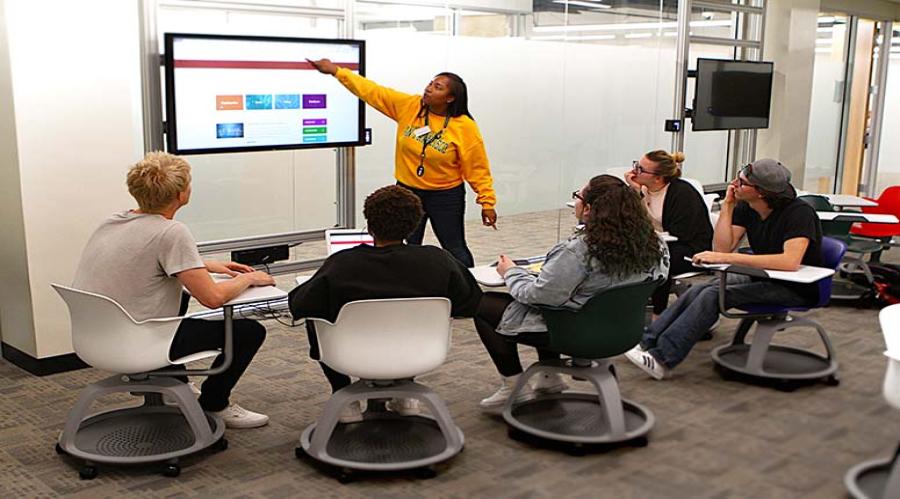Implementing Active Learning
Active Learning (AL) is an instructional approach that engages students in the materials they are learning through, promoting critical thinking and collaboration between educators and learners.
USF’s commitment to academic excellence includes the conversion of all qualified classrooms into active learning spaces in support of two University Strategic Initiatives:
- Increasing technology solutions to enhance learning and improve service; and
- Facilities to support outstanding educational programs.
This webpage provides resources on how to incorporate active learning into your teaching and information about existing active learning spaces at USF.
![Venn diagram representing the interconnected relationship of pedagogy, [learning] space, and technology in the active learning ecosystem.](/sites/default/files/images/ets/ets-ale-activelearningecosystem.png)
Active learning pedagogies promote the retention and deeper understanding of material, as students are engaging with content rather than passively listening. Bligh (1998) found that among students who are actively engaged in class, far fewer experience a "drop off" in concentration; after just 10-15 minutes, a learner stops listening effectively. Freeman et al. (2014) further notes that students' exam scores improved by about 6% in active learning sections.
In addition, flipped pedagogical approaches encourage students to acquire and construct their own knowledge: “A lecture can transmit information in a way that engages and even inspires students . . . In this student-centered approach, the teacher gives up the role of the “sage on the stage” and becomes the “guide on the side” (Bernstein, 2018, p. 291).
A 2018 EDUCAUSE publication describes Active Learning Classrooms as a vital innovation in contemporary learning, indicating spaces that promote student engagement and collaboration positively impact students' class performances. Although research remains in development, colleagues at North Carolina State University, UC Berkeley, and the University of Washington have launched pilots for expanding ALCs across their campuses. ALCs challenge instructors to incorporate technology and reframe knowledge acquisition as a two-way relationship with students.
ADDITIONAL READING:
- What's The Use of Lectures? (Bligh, 1998, 1e) | Available electronically at Gleeson Library
- "7 Things You Should Know About Research on Active Learning Classrooms" (EDUCAUSE)
- "Do interactive learning spaces increase student achievement? A comparison of classroom context" (Vercellotti, Active Learning in Higher Education)
- "Technological Innovation or Educational Evolution? A Multidisciplinary Qualitative Inquiry into Active Learning Classrooms" (Gordy et al., Journal of the Scholarship of Teaching and Learning)
- "Active learning increases student performance in science, engineering, and mathematics" (Freeman et al., PNAS Early Edition)
- "Does Active Learning work?" (Bernstein, 2018, Scholarship of Teaching and Learning in Psychology)
John Belcher (Professor of Physics, MIT) and fellow instructors at the university began the Technology Enhanced Active Learning (TEAL) Project to analyze student success in their courses. Since the project's conception in the late 1990s, the principal researchers have developed new first-year physics courses that combine traditional lecture-based teaching with flipped teaching techniques including interactive presentations and opportunities for students to collaborate.
Suggested resources:
- Case Study: "Student Engagement in Large Classes with Poll Everywhere" (Teaching@Tufts University)
- "Technology for active learning" (Dori et al., Materials Today)
- "Technology in Teaching" (Stanford University - Teaching Commons)
USF is committed to supporting TEAL through the opening of Gleeson 213, the university's first TEAL classroom. This space features (6) LCD TVs and a main AV system, each supporting connectivity via HDMI and AirPlay. The room also includes (40) Steelcase "Node" chairs for flexible rearrangement.
Read the story: Creating Gleeson 213

USF has a variety of classrooms with flexible furniture and enhanced technology to support active learning. The interactive table below highlights these spaces.